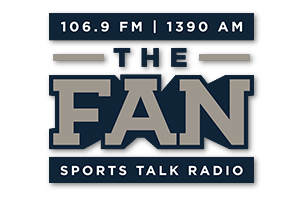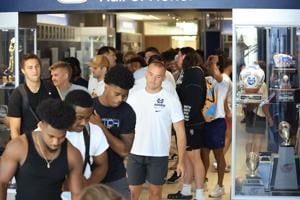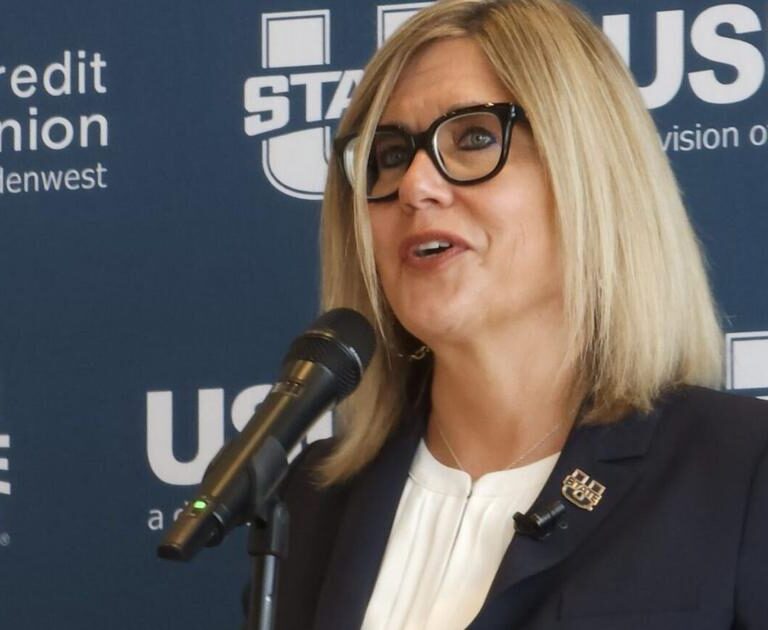Utah State guard Sean Bairstow (2) goes up for a dunk against Colorado State during the first half of an NCAA college basketball game in the quarterfinals of Mountain West Conference men’s tournament Thursday, March 10, 2022, in Las Vegas. (AP Photo/Rick Bowmer)
LOGAN – When it comes to the low expectations for the Utah State men’s basketball team (picked to finish eighth in the Mountain West preseason poll), the focal point is likely a combination of the loss of forwards Justin Bean and Brandon Horvath and a lack of confidence that head coach Ryan Odom has adequate replacements for those two players, especially offensively. Those two players were the Aggies’ leading scorers with a combined 31.3 points per game (17.4 for Bean, 13.9 from Horvath).
Finding replacements for those two players is far easier said than actually done, but there are a few candidates on USU’s roster who can either step up or step in to the void left by Bean and Horvath.
Odom didn’t bring in any high-scoring transfers, but St. Joseph’s transfer Taylor Funk has an offensive skillset that could lend itself to being one of, if not the, top scoring options at Utah State. Funk is a sharpshooter, one of 63 players to shoot 37 percent from three on at least 200 attempts last year. Though Odom made sure to note that Funk is an “all-around player.”
“Certainly, he’s known for his jump shot. When you see him shoot the ball it’s about as pretty as it gets,” Odom said. “But he’s more than that. He’s a rebounder, he’s a guy that can control the glass and rebound his position. He’s a guy that works hard to defend his position. And he’s a guy that moves off the ball very well.”
Despite being a newcomer to the team, Funk was named one of four team captains on the squad.
“It’s rare that you’d name a newcomer a captain in Taylor Funk. But he’s earned that,” Odom said, adding that Funk has “hit the ground running, has connected with his teammates and really earned his way within this team.”
Among players already on the team poised for potential leadership, senior guard Sean Bairstow is a top candidate. Last year Bairstow began to step into a larger role, starting 18 of the final 19 games he appeared in. He averaged 10.3 points on 7.8 field goal attempts in those 19 games, shooting 52.3 percent from the field.
There’s a world in which Bairstow sees a jump in scoring this year like the one Bean had between 2020-21 and 2021-22. Bean went from averaging 11.7 points in a two-season span from 2019 to 2021 to scoring 17.4 per game his final season of 2021-22. A big part of that jump was stepping into a larger role left by the staggered departures of Sam Merrill and Neemias Queta. Once both were gone, Bean went from averaging a little under nine field goal attempts per game all the way to 12.5 attempts. If you take Bairstow’s shot distribution and percentages and apply them to a 12.5 field goal attempt average he’d jump from his 9.5 PPG average last year all the way to 14.7.
Bean’s scoring jump didn’t come solely from a rise in field goal attempts, though. He also produced a jaw-dropping improvement in 3-point percentage. After going 19-of-77 (24.7 percent) from across three seasons, Bean made 46-of-99 (46.5 percent) attempts from downtown in 2021-22. Had Bean not increased that percentage, his 17.4 points per game would have been a mere 15.5.
Bairstow is certainly a player who could use a jump in 3-point shooting. Last year he shot just 12.5 percent from three 48 attempts throughout the season – the worst percentage in the NCAA among players with as many attempts. In his first two seasons, Bairstow shot a combined 18-of-50 (36.0 percent) from three.
“It was definitely a focus for me,” Bairstow said when asked if his shooting was an offseason focus. “I feel like I’ve always had it, but it kind of went away last year. So it’s really just getting that confidence back and getting in the gym and getting the reps up and just getting ready for this year.”
“He’s really developed his jump shot over the course of this spring, summer and fall,” Odom said, “and has become a more confident shooter from the perimeter. And I’m excited for our Aggie fans and those in the Mountain West to see him play this year.”
Had Bairstow shot that same 36.0 percent in 2021-22, his scoring total would have been 11.6 rather than 9.5. And perhaps some of that lost touch from three came from a preseason injury that forced Bairstow to miss the early part of the season and work his way back into health with the season already under way.
A dark horse candidate to burst onto the scene as a scorer is junior guard Max Shulga. The Ukrainian guard played just 13.7 minutes per game last year but this offseason he showed a leading scorer’s spirit in the FIBA U20 European Championship. Though the Ukrainians struggled in the tournament, Shulga averaged 18.3 points, 5.9 rebounds and 4.4 assists. He was the only player in the tournament to finish top 10 in both points and assists among the participants.
“As soon as the season ended, Max was right in the gym working on his game, trying to improve,” Odom said. “He’s got big goals for himself and certainly wants to be a major player for this team. He carried that into the summer and did really well with his national team.”
Shulga showed an aggressive mindset on both sides of the ball in the Blue/White scrimmage held earlier this month, leading all Aggies in points, assists and steals. And though he is likely looking at a bench role to start the year, things may not stay that way.
While from an outside perspective, individual players are being lined up as potential focal points for this team, a major point of emphasis from the team is to play as one, creating for each other and not just for themselves. According to senior guard Rylan Jones, one of the favorite phrases of Utah State basketball assistant coach Bryce Crawford is “the power of the pass,” something Jones elaborated on.
“We do talk about the power of the pass and how the passing can create for our offense,” Jones said. “We’re also just unselfish players and it’s our playstyle and it’s also been the playstyle of Utah State teams in the past so we’re keeping the tradition going. And last year we were able to be the number one team in assisted baskets and we’re looking to do the same this year.”
Just under 67 percent of USU’s made field goals last year had an assist attached to it. Which, as both Jones and Odom mentioned at media days, was the best mark in Division I. And the team retains most of its best passers in Jones (4.5 assists per game last year), Ashworth (3.6), Eytle-Rock (1.9), Bairstow (1.4) and Shulga (1.0). Even incoming players should fit in the system well. Transfer forward/center Dan Akin is coming from Cal Baptist who ranked second in assisted field goal percentage behind USU, and should thus feel right at home in a pass-happy offense.






